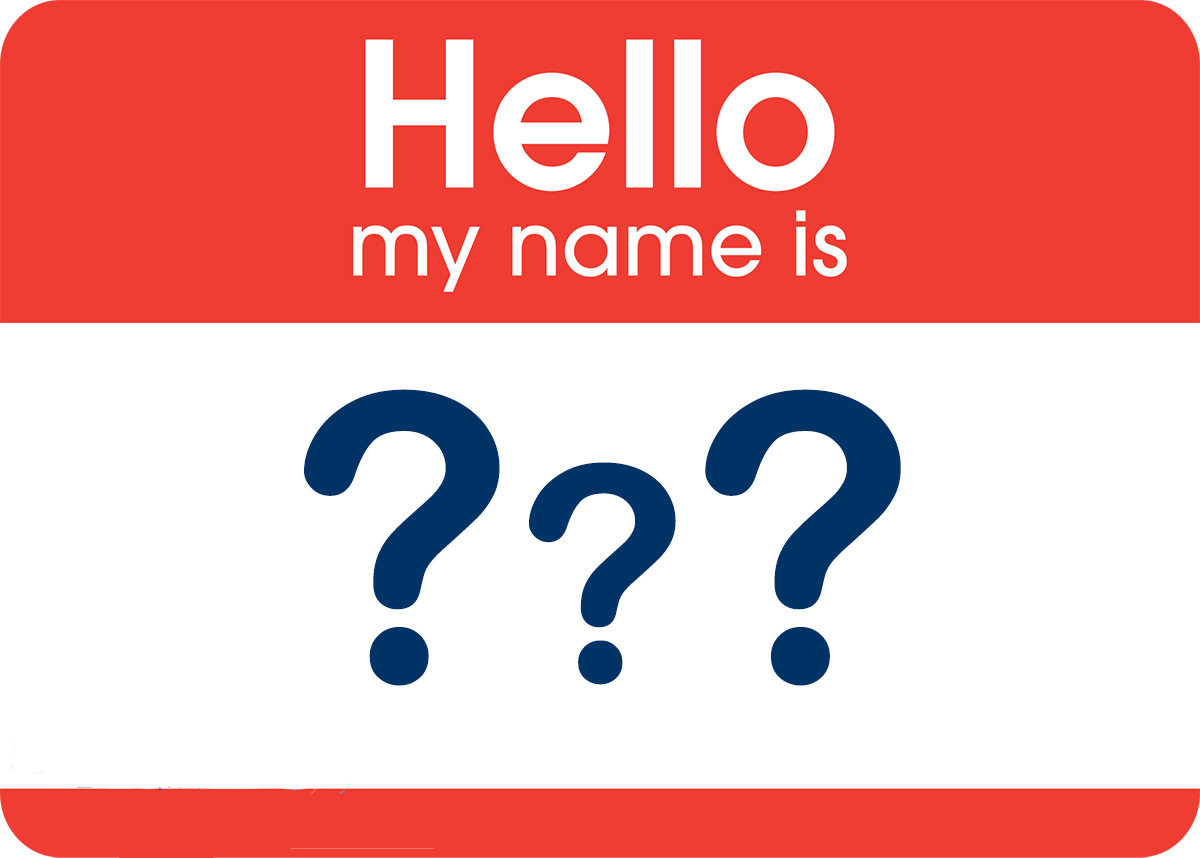Fit to brand. What will they call you?
The topic of this article is Verbal Identity. What is that you say? Simply put, your verbal identity is the linguistic/word-based component of your brand. In the case of larger enterprises or corporations, it encompasses a broad number of items, but for our purposes, we will limit our overview of verbal identity to your brand name and marketing/descriptor tagline. shorturl.at/cerJM
"A good name is rather to be chosen than riches."
— King Solomon
Making a Name for Yourself. The Challenge of Naming a Business
In today’s competitive marketplace, adopting or creating a name for your business offering – whether a service, product, or organization – that is memorable and meaningful while also available, can be challenging. Unless you decide that your own name should be the brand of your new venture, then this article may not be for you. But for all others who are looking to brand their offering with a name that will position it in the most advantageous way, listen up. Naming an offering in a way that is brandable, may appear easy. It is neither easy nor simple. Let us consider some of the challenges you will encounter in the process:
According to the latest numbers from Statistics Canada, as of June 2021 there were 4,252,900 active businesses in Canada. These are businesses with annual revenues greater than $30,000.
As per the US Small Business Administration, there are over 29.6 million small businesses in the United States, and on average, 540,000 new businesses are started every month.
Each of these businesses has registered a name, and a good percentage have registered trademarks on those names.
For the year 2016-2017, the last year for which records are available, the Canadian Intellectual Property Office (CIPO) records that 55,446 trademark applications were made in Canada, and as of 2019, also the last year for which records are available, 893,760 trademarks were registered with the United States Patent and Trademarks Office. Many of these would be international trademarks, and therefore enforceable in Canada.
If you consider brand naming purely a function of language, you must also consider the limitations of such. The Merriam-Webster English dictionary contains about 470,000 words. It’s a pretty safe bet that most “usable” or “useful” words have been used in one form or another in a trademark.
All this to say that whatever clever name you were thinking about, someone has probably been there already. But do not despair. You can still have a great name that will be unique and serve your business well. Here are some steps to help get you there:
1. Survey the landscape
My last article suggested that you conduct a competitive audit to familiarize yourself with the other players in your sector. Chances are, you already know many of their names and broadly how they position themselves. It is important to capture this information in a formal manner, from an analytical perspective. You want to make sure that you can develop a name and a positioning that will, in no way, have you be confused for theirs, in the minds of customers. It is simply basic due diligence, but it is a critical first step.
2. Formalize your unique value proposition
I suggest a good place to start would be to work on your unique value proposition (UVP). Beside the fact that your UVP should play a leading role in your marketing, it can also help you identify promising naming directions, and it should help you produce a tagline that ideally summarizes your UVP. A UVP should refer to the “big picture”. That is, it should be broad in nature and reflect the brand promise and/or benefits clients can expect and are willing to pay for.
Begin with asking yourself what is unique or different about your offering, that is either not currently existing in the marketplace, or that is delivered in such a way as to provide a differentiated experience. What are the main benefits clients will get from transacting with you? Is access to your location a big part of it? Do you offer a personal or customized approach? Are your facilities, settings, or the type of equipment or training you offer different? Is your methodology/system different? What do you offer as a promise for your clients? Is the focus of your gym or practice highly specialized or different from others? Are you highly inclusive or do you appeal to a select clientele? There are many more questions of this type that can help you hone in on a unique value proposition statement.
The answers to these, and other questions like them, should help you create a unique value proposition that can be used as a source of ideas for developing naming options.
3. Types of names
There are many types of naming approaches. Hopefully, the UVP exercise above will help guide your efforts and decide what you want your new name to do for your marketing, branding, and promotion efforts. Making this decision may allow you to narrow your name search down to a specific type of name. Without going into great detail about each, here are some of the primary types and categories:
Descriptive - This category would include names like Google Maps and The Weather Channel. In your sector, National Gym & Fitness Centre fits this description.
Experiential or Suggestive - This category would include names like Safari and Twitter. In your sector, Philosophy Fitness fits this description
Evocative or Expressive - This category would include names like Apple and Virgin. In your sector, OrangeTheory Fitness fits this description.
Made up/Invented Names - This category would include names like Verizon and Pixar. In your sector, Energia Athletics fits this description.
Proper Nouns - This category would include names like Hewlett-Packard and Tim Hortons. In your sector, Jessie Humble Fitness, or the Adelaide Club fit this description.
There are further sub-categories to a few of these options that we are not able to go into in this article.
Each type of name comes with its own pros and cons. Fanciful or imaginative names aim to create an impression or paint some picture of what it would be like to transact with you, while more straightforward names with concrete words communicate more plainly what you do. Books have been written on the subject, and there is much more to be said about the merits of one approach over another. However, each approach needs to be considered in the full context of the sector you are operating in, the size of the enterprise you lead and the means at one’s disposal to create awareness for your brand. You may already know what approach would work best for your purposes; however, I will offer you the benefit of a free consultation should you wish to discuss your options with me. My contact information can be found at the end of this article.
4. Naming structures
Business names are mostly layered entities. You will notice that beyond the “brandable” portion of the name, most of the organizations in your sector also append a descriptor to their brand name. Whether it be Fitness, Athletics, Gym, CrossFit or Training, these descriptors help anchor your brand offering in the minds of the customer.
5. Test for availability
I should have started this article with this bit of wisdom: A good name is one that is available. By now, you are somewhat familiar with the challenges you will be facing in this process. Do not let that deter you, but before you fall head-over-heels in love with your perfect new brand name, it would be wise to conduct an availability search.
Once the ideas start coming to me, my step is always to do a quick Google search, entering different iterations of name candidates I am considering in the browser. Even if something comes back indicating a potential conflict, it does not mean that this is the end of the road for a potential name. Many factors can come into play to determine whether a name conflicts with another existing brand, not the least of which is the specific sector/industry or business, the companies with similar or identical names are operating. For instance, the already established Clear Skies Windows and Doors Company should, in theory, have no trademark conflicts with upstart Clear Skies Hang Gliding Club. I said, “in theory”. Some trademarks, mostly those of larger corporations or market leading consumer products have trademark protection that is extremely broad. So, I do not care if your name if Sue or Bob Reebok. Do not start a gym call Reebok Fitness.
6. To trademark or not to trademark
Not every business needs a registered trademark. A trade name is the official name under which you choose to do business. A trademark provides a company's brand with legal protection. The practical function of registering a trade name is primarily for administrative, accounting and tax purposes, but it does not always provide legal protection for the use of that name. That is why you should avoid choosing a name that is too close to a registered trademark, as this could expose you to a potential lawsuit.
Using a trade name that is not a registered trademark with the Canadian Intellectual Property Office for a certain length of time, may grant you certain exclusivity rights under common law. However, if your rights to use the name are challenged, you could end up in a legal battle over who has the right to use it. I recommend consulting a trademark attorney or at least a trademark search firm to make sure your new name does not infringe on another business trademark.
About Taglines
A tagline may be conceived prior to finalizing your name, as it can act as a condensation of your UVP. However, if you decide you require a tagline, I recommend you hold off until you have locked the name down. The name and tagline should work in tandem, and I have seen many cases where the chosen name influenced the direction of the tagline.
But what is a tagline for? Among other things, it should elicit a response from customers in one of the following ways:
Clarify what you do, or how you do what you do
Express an important brand attribute or benefit to the audience
Support your general positioning
Help people recognize and remember you
Act as a call to action
Writing a good tagline can be challenging, but it can add extra dimension to your brand recognition and awareness. Bear in mind that you are not a multi-national with a big marketing budget so, if you get creative with it, make sure you keep it relevant. So “Just Do It” may not be for you; at least not yet. On that subject, understand that taglines are also trademarks. Do your homework. Here are a few criteria for an effective tagline:
Keep it short – three to five words is ideal. Longer than that, they become forgettable.
Convey a single simple idea or benefit
If possible, be both specific and aspirational
Be sure any claim you make is believable
Make it memorable and meaningful
One Last Thing...
A new brand name may not feel quite comfortable at first, especially if you had your heart set on another and found out you could not use it. But remember this: A name will grow on you, and you will grow into that name, by investing it with meaning and value over time, through the excellence of your service, the experience you provide your clients, and the reputation you continue to build day after day. That is when your name will truly become a brand.
Resources:
For information on registering your business name: https://www.ic.gc.ca/eic/site/053.nsf/eng/00004.html
For more on trademarks visit: https://www.ic.gc.ca/eic/site/cipointernet-internetopic.nsf/eng/home



